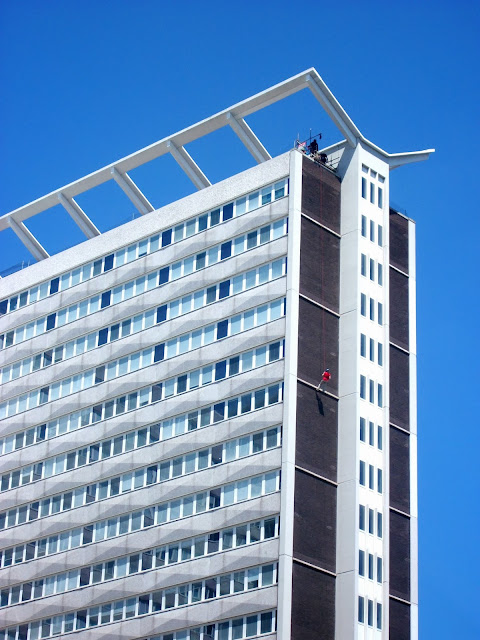The Washington New Town plan was drawn up by the same team who worked on Milton Keynes: the snappily named Llewelyn-Davies, Weeks, Forestier-Walker and Bor. The Washington New Town plan book was published in 1966, and the Milton Keynes initial plan followed four years later. In terms of presentation, the two plans couldn't have been more different. The Washington New Town book was a plain brown landscape-format hardback. It contained very little colour, and outline sketches were completed in rough pencil. The Milton Keynes plan was soft-backed folder in vivid aquamarine, and the plans inside were in bold clean lines and coloured bright orange, red, blue and green.
I'm fascinated by the Washington New Town plan. The book may be unshowy, but it is beautifully designed. It contains much of the same basic information as the MK one, but lacks the radical large-scale thinking of the Buckinghamshire town. This may be because Washington was smaller scale, chiefly connecting up villages, rather than dwarfing existing towns as in MK. But they shared many similarities, including naming: MK's famous grid roads were known for a long time simply as Vertical or Horizontal numbers, such as the V4 or H7; and Washington's individual estates were known simply by number for many years.
I've scanned some of the drawings from the long out-of-print Washington New Town plan. They appear to be the work of an artist who signed them simply Brookewhite. Whether this was Chris Brookewhite, the New Zealand architect, I don't know. There's no further reference to the artist in the book. But they are brilliant and beautiful pencil drawings, presenting a rugged and monochrome image of the projected town, somewhat reflected in the actual architecture, although never as stylishly optimistic and futuristic as depicted here. I've included the original captions from the pictures to add a bit of context.
 |
| Fatfield Centre could be given a distinctive character by taking advantage of its waterfront location, as this artist's impression suggests. |
 |
| View of a village centre bringing together a primary school, youth club, bus stop, village common room, pub, shops and local employment. Some existing buildings are retained to add to the character of the centre. |
 |
| Industrial estate approached from residential area. Well designed factories will help to give variety to the town. |
 |
| The Shopping Centre and Sports Stadium. |
 |
| The edge of a village. A clear difference between built up areas and open spaces will help to define the villages. A consistent architectural approach, giving rise to a unified appearance throughout each individual village, could help to distinguish between them. |
 |
| A development road. People may be expected to have as many friends across the street as across the communal garden. |
 |
| A communal garden. In each village a proportion of households will be planned around enclosed, semi-private gardens, the use of which is reserved for the housemates surrounding them and where the youngest children can play in complete safety. |
 |
| The Shopping Centre and Sports Stadium seen from the primary network. |


















Intrigued to see the name on the front of the shop on the top picture (Waitrose!) In 1966? In the North East? I guess that the artist came from the south east!
ReplyDeleteTim Skelton
Ha! Yes, as you say, Waitrose didn't expand out of the South until fairly recenlty, which is a bit of a giveaway...
Delete